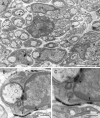Promyelinating Schwann cells express Tst-1/SCIP/Oct-6
- PMID: 9742157
- PMCID: PMC6792991
- DOI: 10.1523/JNEUROSCI.18-19-07891.1998
Promyelinating Schwann cells express Tst-1/SCIP/Oct-6
Abstract
Tst-1/SCIP/Oct-6, a POU domain transcription factor, is transiently expressed by developing Schwann cells and is required for their normal development into a myelinating phenotype. In tst-1/scip/oct-6-null sciatic nerves, Schwann cells are transiently arrested at the "promyelinating" stage, when they have a one-to-one relationship with an axon but before they have elaborated a myelin sheath. To determine when Schwann cells express Tst-1/SCIP/Oct-6, we examined beta-galactosidase (beta-gal) expression in heterozygous tst-1/scip/oct-6 mice, in which one copy of the tst-1/scip/oct-6 gene has been replaced with the LacZ gene. beta-Gal expression from the LacZ gene seems to parallel Tst-1/SCIP/Oct-6 expression from the endogenous tst-1/scip/oct-6 gene in developing and regenerating sciatic nerves. Furthermore, electron microscopic examination of 5bromo-4-chloro-3-indolyl-beta-D-galactopyranoside- (X-gal) and halogenated indolyl-beta-D-galactoside- (Bluo-gal) stained nerves showed that promyelinating Schwann cells express the highest levels of beta-gal, both in developing and in regenerating nerves. Thus, the expression of beta-gal, a surrogate marker of Tst-1/SCIP/Oct-6, peaks at the same stage of Schwann cell development at which development is arrested in tst-1/scip/oct-6-null mice, indicating that Tst-1/SCIP/Oct-6 has a critical role in promyelinating Schwann cells.
Figures









References
-
- Bermingham JR, Jr, Scherer SS, O’Connell S, Arroyo E, Kalla K, Powell FR, Rosenfeld MG. Tst-1/SCIP/Oct-6 regulates a unique step in peripheral myelination and is required for normal respiration. Genes Dev. 1996;10:1751–1762. - PubMed
-
- Blanchard AD, Sinanan A, Parmantier E, Zwart R, Broos L, Meijer D, Meier C, Jessen KR, Mirsky R. Oct-6 (SCIP/Tst-1) is expressed in Schwann cell precursors, embryonic Schwann cells, and postnatal myelinating Schwann cells: comparison with Oct-1, Krox-20, and Pax-3. J Neurosci Res. 1996;46:630–640. - PubMed
-
- Gupta SK, Pringle J, Poduslo JF, Mezei C. Induction of myelin genes during peripheral nerve remyelination requires a continuous signal from the ingrowing axon. J Neurosci Res. 1993;34:14–23. - PubMed
-
- Hahn AF, Chang Y, Webster Hd. Development of myelinated nerve fibers in the sixth cranial nerve of the rat: a quantitative electron microscope study. J Comp Neurol. 1987;260:491–500. - PubMed
Publication types
MeSH terms
Substances
Grants and funding
LinkOut - more resources
Full Text Sources
Molecular Biology Databases
